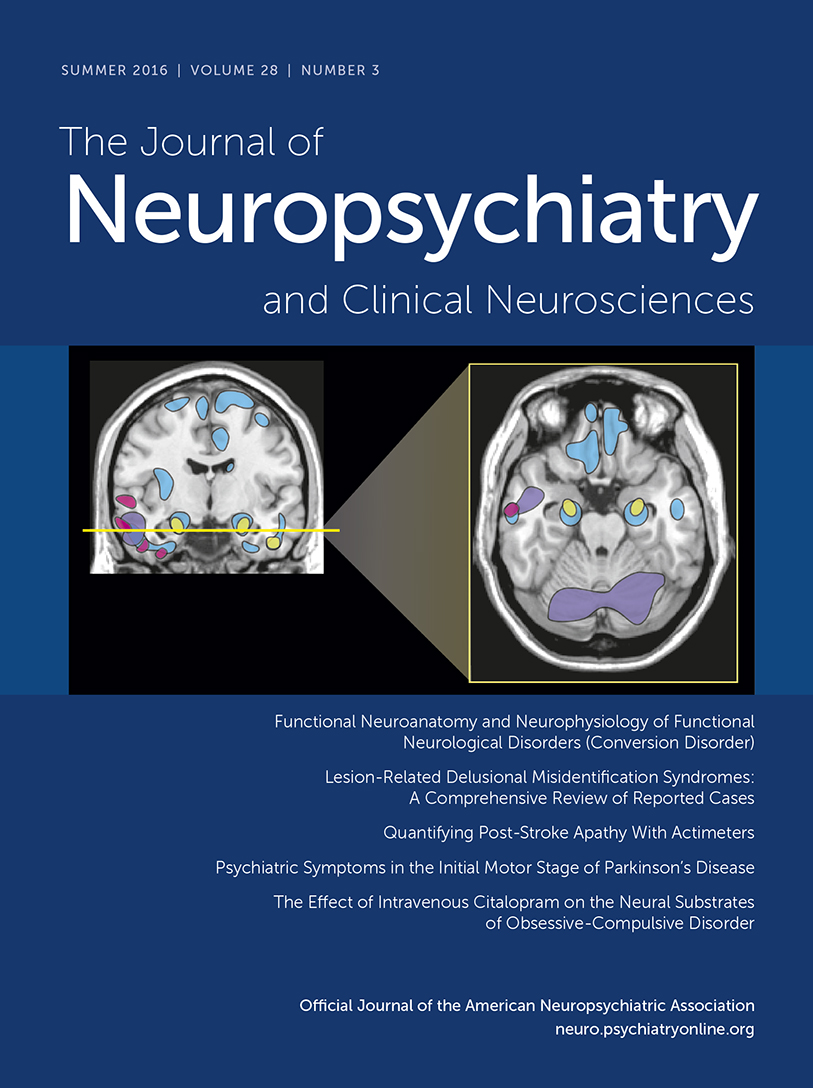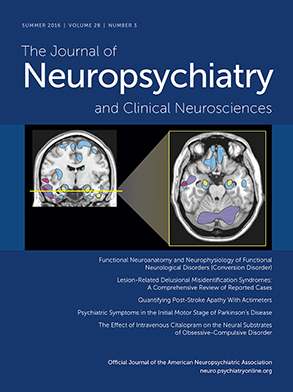Psychogenic movement disorders (PMDs), also referred to as functional movement disorders, can resemble almost any organic movement disorder. PMDs can affect any muscle or group of muscles under volitional control, including those involved in ocular movements. Psychogenic disorders often present to ophthalmologists or neuro-ophthalmologists because they can affect vision, pupillary function, corneal sensation, eyelids, and ocular movements.
1 Convergence spasm, characterized by transient episodes of ocular convergence, miosis, and accommodation evoked by examination of horizontal gaze, is one of the most common oculomotor abnormalities associated with PMDs, present in 9 of 13 (69%) patients in one series of PMDs.
2 In this study, we aimed to identify the frequency, characteristics, and clinical correlations of spontaneous (observed without maneuvers to assess oculomotor functions) psychogenic ophthalmologic movement disorders (POMDs).
Results
Among 182 consecutive patients with PMDs evaluated in our clinic during a 2-year period, we identified 11 (6%) with POMDs. There were seven women and four men with a mean age at onset of 28.1±17.67 years. POMDs were classified as follows: opsoclonus (n=3), oculogyric crises (n=6)—manifested in three patients by sustained supraversion and in three patients by brief oculogyric movements in different directions—opsoclonus and oculogyric crises (n=1), and opsoclonus with movements resembling ocular flutter (n=1) (
Table 1). Nine of 11 patients reported symptoms related to the ocular movements, including episodic oscillopsia (n=4), intermittent inability to fixate (n=2), and “blindness” associated with persistent supraversion and psychogenic blepharospasm (n=2). Two patients reported no symptoms related to the abnormal ocular movements. The clinical features of patients with and without POMDs are compared in
Table 2. Psychogenic dystonia, including blepharospasm, was the most common associated PMD (n=6), followed by tremor (n=4) and gait disorder (n=3). No statistical difference in the distribution of PMDs was found after comparing patients with and without POMDs (
Table 2), although there was a trend for a younger age at onset in patients with POMDs compared with those without POMDs (p=0.07). Three patients (case patients 4, 7, and 8) received an ophthalmological and neuro-ophthalmological evaluation. Patients with blindness related to persistent supraversion with blepharospasm and photophobia (case patients 7 and 8) were evaluated with automated perimetry, visual acuity, visual evoked potentials, and an electroretinogram. The results of all these studies were unremarkable, except for corneal abrasions in case patient 7 that were treated with steroids and antibiotics with complete resolution; however, there was no change in her ocular manifestations.
A psychiatric evaluation was carried out in eight patients. Depression was diagnosed in three patients, depression with anxiety in two patients, and obsessive-compulsive disorder in two patients; no psychiatric diagnosis was reached in four patients (
Table 1). Seven patients recognized possibly relevant stressors in their lives; these stressors were related to family issues in five patients and work and/or school-related problems in four patients. Four patients denied the presence of stressors (case patients 3, 7, 9, and 11). Regarding prognosis, two patients (case patients 7 and 8) had persistent ocular symptoms despite treatment with botulinum toxins and psychotherapy. Seven patients (case patients 1, 2, 3, 5, 9, 10, and 11) showed improvement in their POMDs and PMDs with psychotherapy and pharmacological therapy of an associated psychiatric condition. Two patients (case patients 4 and 6) were lost to follow-up.
We present three illustrative cases to draw attention to the broad spectrum of phenomenology.
Case Patient 1
This 17-year-old boy presented for evaluation of a 7-year history of opsoclonus. Extensive immunological and oncological evaluations were carried out in another institution involving neuroimaging, whole-body positron emission tomography, CSF including oligoclonal bands, and a myriad of antibodies. Results on all these studies were unremarkable. This patient and his mother claimed that gluten caused attacks of axial dystonia and abnormal ocular movement lasting from 10 to 15 minutes. There was prominent suggestibility for the attacks of opsoclonus and dystonia, with spells triggered with gluten-free food (but which he thought contained gluten). There was a 7-year delay before the diagnosis of PMD. The patient and family accepted the diagnosis of POMD, and he improved with psychological counseling and psychotherapy.
Case Patient 8
This 47-year-old woman was referred for evaluation of a 12-year history of episodic eye closure, periocular pain, and photophobia. She was diagnosed with psychogenic blepharospasm due to inability to open her eyes, although no active contractions of the orbicularis oculi muscles was observed, and an attempt to open her eyes showed persistent bilateral ocular supraversion. The patient acknowledged marked stress related to family issues. Treatment with psychotherapy and botulinum toxin in her eyelids has been tried without success.
Case Patient 11
This 15-year-old boy presented for evaluation of a 1-year history of hand trembling and whole-body shaking along with abnormal gait. Examination showed episodes of brief ocular infraversion and supraversion—some of them spontaneous and some when attempting ocular pursuit. His abnormal movements varied widely in intensity and direction and were easily distractible. He has tried chiropractor manipulation and acupuncture without success. He has been homeschooled because of the disabling nature of his symptoms. Stress management was recommended and was associated with subsequent resolution of all symptoms.
Discussion
We found POMDs to be present in approximately 6% of patients with PMDs. The abnormal ocular movements—classified as opsoclonus, eye flutter, and oculogyric crises—were typically associated with other PMDs, which resulted in referral for movement disorder evaluation.
Oculogyric crisis is characterized by spasms of extraocular muscles leading to eye deviation (mostly upward), each spasm lasting from seconds to several hours, with the entire episode lasting up to several weeks or months.
5 Oculogyric crises were first described in patients with encephalitis lethargica; currently, they are more commonly observed after exposure to antiemetics, antidepressants, antimalarials, antipsychotics, and other drugs that block dopamine receptors and cause acute dystonic reaction or tardive phenomenon.
6,7 These reactions are believed to be caused by striatal blockade of dopamine D2 receptors resulting in an excess of cholinergic tone in the basal ganglia.
8,9 Oculogyric crises have also been reported in dopamine-responsive dystonia, Wilson's disease, non-Wilsonian hepatocerebral degeneration, cystic glioma, bilateral thalamic and striatocapsular infarctions, and herpes encephalitis.
5,10,11 Differential diagnosis includes paroxysmal tonic upward gaze in childhood, eye tics, and epileptic versive crisis.
8 In our series, none of our patients had recent exposure to the above classes of drugs or any identifiable neurological disorder that could explain the oculomotor abnormalities. The temporal association with other PMDs strongly suggests a psychogenic origin of the abnormal movements. Another important feature is that organic oculogyric crises can be overcome by the patient at least transiently under volitional control; however, patients with psychogenic oculogyric crises are frequently unable to do so, but the ocular movements may stop with distraction. We identified two types of oculogyric crisis: 1) a brief form lasting few seconds and 2) a persistent form associated with psychogenic photophobia and blepharospasm resulting in functional blindness in two patients. In the latter case, it is unclear whether sustained supraversion represents a form of accentuated Bell's phenomenon or another psychogenic phenomenon. Psychogenic blepharospasm and persistent supraversion resulting in functional blindness differ from psychogenic visual loss related to altered visual acuity, defects on visual fields, or amaurosis with the eyes open,
12,13 which can certainly occur in the context of other psychogenic phenomena but were not identified in our patients.
Opsoclonus and ocular flutter are saccadic oscillations without intersaccadic intervals.
14 Ocular flutter consists of pendular horizontal conjugate saccades, whereas opsoclonus consists of conjugate multidirectional ocular movements occurring in random directions with varying amplitudes.
14 We identified five patients with psychogenic opsoclonus; two of them also had another type of POMD (brief oculogyric crisis and ocular flutter). Patients with organic opsoclonus usually describe symptoms suggestive of oscillopsia and diplopia causing prominent disability in some instances. The clues that suggest a psychogenic origin of the movements are similar to those discussed for oculogyric crisis. The list of organic etiologies of opsoclonus and ocular flutter is large and includes paraneoplastic disorders (i.e., primary neuroblastoma in children, small cell lung carcinoma, breast or ovarian carcinoma in adults), autoimmune conditions (i.e., anti–
N-methyl-
d-aspartic acid receptor encephalitis), and infectious, metabolic, and toxic disorders.
14,15 Patients with neuroblastoma may present with the so-called opsoclonus-myoclonus syndrome, a condition with onset usually in the second year of life.
16 Besides opsoclonus, patients have myoclonus, ataxia, and sleep disturbances. None of these features were observed in any of the reported cases here, and the age at onset in our patients would be atypical for opsoclonus-myoclonus syndrome. It should be noted that in a majority of patients with opsoclonus, no specific cause is found,
16 and a psychogenic cause should be considered in those instances. Some PMDs can be present in the setting of organic disorders, making the diagnosis even more challenging.
7,17 Although not tried in any of our patients, the “eye movement desensitization and reprocessing” therapy has proved useful for the treatment of depression, anxiety, and posttraumatic stress disorder, and in a few cases with psychogenic seizures,
18 and could be valuable for patients with POMDs.
Our study had limitations, including the retrospective collection of data; however, detailed clinical assessments and video recording reduced the probability of missing participants with POMDs. Another limitation was the lack of oculographic recordings, although clinical examination is considered sufficient to classify these movements according to the observed phenomenology.
In conclusion, spontaneous POMDs are present in approximately 6% of patients with PMDs usually accompanied by ocular symptoms, such as oscillopsia, inability to fixate, and functional “blindness.” Correct diagnosis of POMD may avoid unnecessary diagnostic tests and should lead to appropriate insight-oriented psychotherapies, physiotherapy, and pharmacological therapy of underlying psychiatric comorbidity.
19,20 Most patients show improvement in their ocular and other psychogenic movements, except for those with functional “blindness” related to blepharospasm, persistent supraversion, and photophobia. Further studies should address whether these patients represent a particular poor outcome group.

